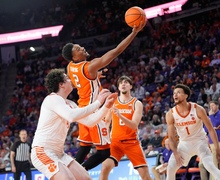Bethel: Female wardrobes at award shows distract from actual talent
Every year, the Grammys and the upcoming Oscars are highly anticipated by the public.
Viewers not only watch for the celebrities that attend, but also for the wardrobes worn by the female guests. Performers such as Lady Gaga, Nicki Minaj and Rihanna are known to walk the red carpet in revealing and unusual ensembles.
Music artists are extremely expressive, and the way they present themselves is representative of the music they produce. However, this year, the buzz around the Grammys wasn’t about the talent, it was about the dress code.
A memo sent out to attendees by CBS politely asked them to make sure to adequately cover their “buttocks and female breasts.” They expressed that thongs, sheer clothing and the possible exposure of nipples and genital region were all problematic.
It was sent to all people invited, though it was very obviously targeted at women. The message immediately caught the attention of the media and circulated quickly. Many artists publicly commented on the content of the letter, some depicted it as humorous and others complained it was stifling their creativity.
Lady Gaga and Nicki Minaj, both famous for their outrageous wardrobes, were not in attendance for the Grammys this year. But that didn’t solve the issue for CBS. Musical artists Katy Perry, Kelly Rowland and Jennifer Lopez all garnered attention for their cleavage and skin-baring outfits.
The hype from the CBS memo resulted in more attention focused on the female attendees’ attire, rather than the purpose of the event, the music. It seemed more exciting for the media to talk about cleavage on the red carpet than who brought home what award.
The entertainment industry is extremely competitive for women. One has to be willing to take chances, not only with her talent, but her appearance, as well. Award shows have become about who shows up wearing the most revealing and unique gown.
Jennifer Lopez is still being talked about for an outfit she wore more than a decade ago. Her green Versace gown, worn to the Grammys in 2000, had a neckline that plunged to below her navel.
These outfits are more than a form of expression, they are a competition for getting noticed. Pop culture thrives on physical appearance; sex is the main selling point for music, movies and television shows.
Artists can skate by on mediocre skill if they have the stereotypical industry image. Looks won’t make one female artist more talented than another, but they do have the ability to make them more liked by the public.
There are some outliers in the industry. Adele took over the music world because of her raw talent. Though Adele is respected, she is not seen as attractive or sexy because her body type does not conform to industry standards.
Legends in the making, such as Beyoncé, are rare because they have both musical talent and beauty.
Female nominees at events like the Grammys do not need to conform to the media’s beauty expectations in order to prove their talent. They have the ambition and the recognition that make them some of the greatest entertainment influences of their time.
But the belief persists that if they dress too modestly, they won’t be remembered.
In a culture like ours, it is tough to determine whether it is possible to be influential and remembered while still being modest. You not only need a bold vision, voice and determination to make a difference, but apparently you also need beauty.
The CBS memo is confirmation of the entertainment industry’s need to make a statement in the media. Artists are too willing to go to drastic measures in order to leave an impression.
Paris Bethel is a sophomore advertising major. Her column appears weekly. She can be reached at pbethel@syr.edu.
Published on February 20, 2013 at 2:11 am





